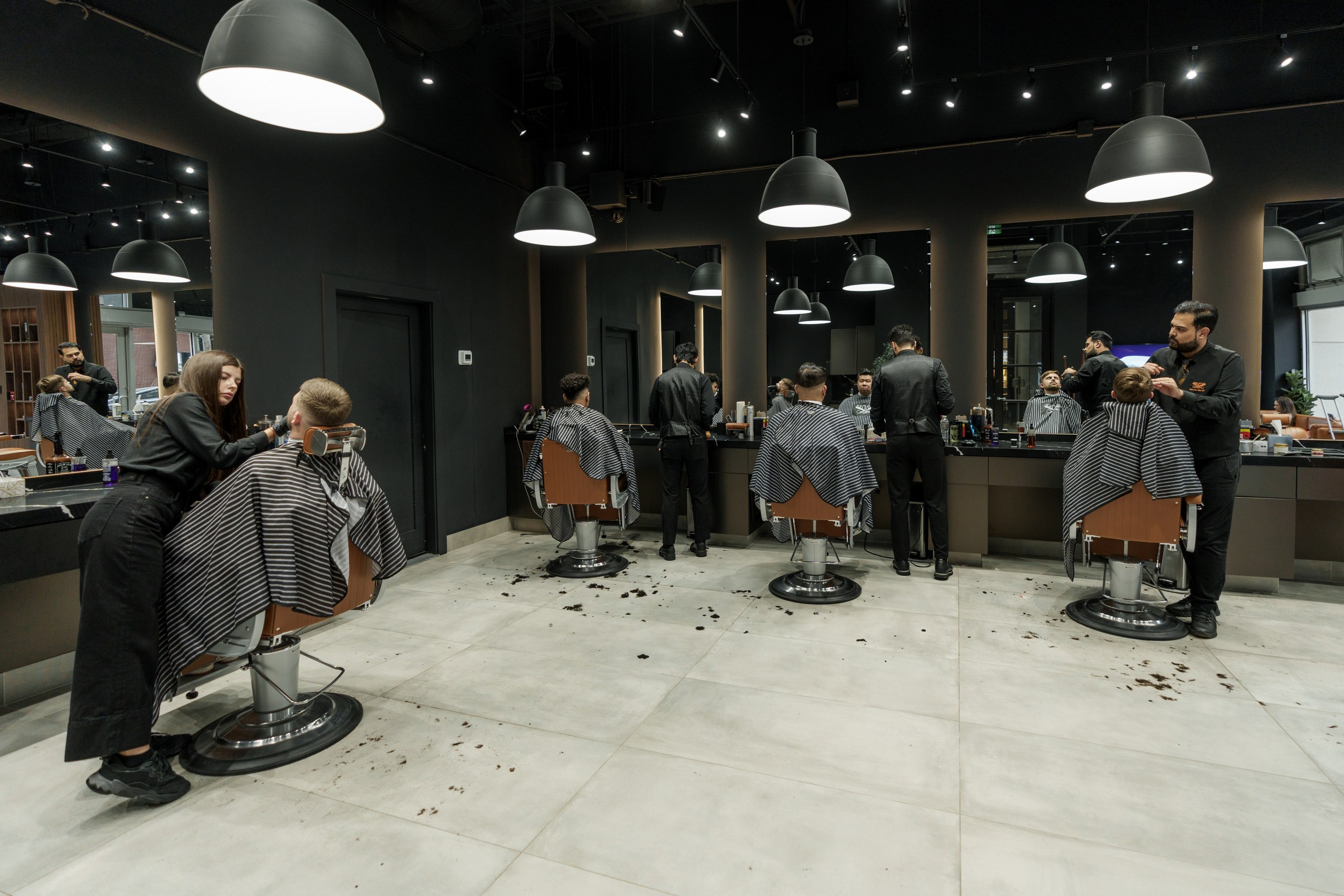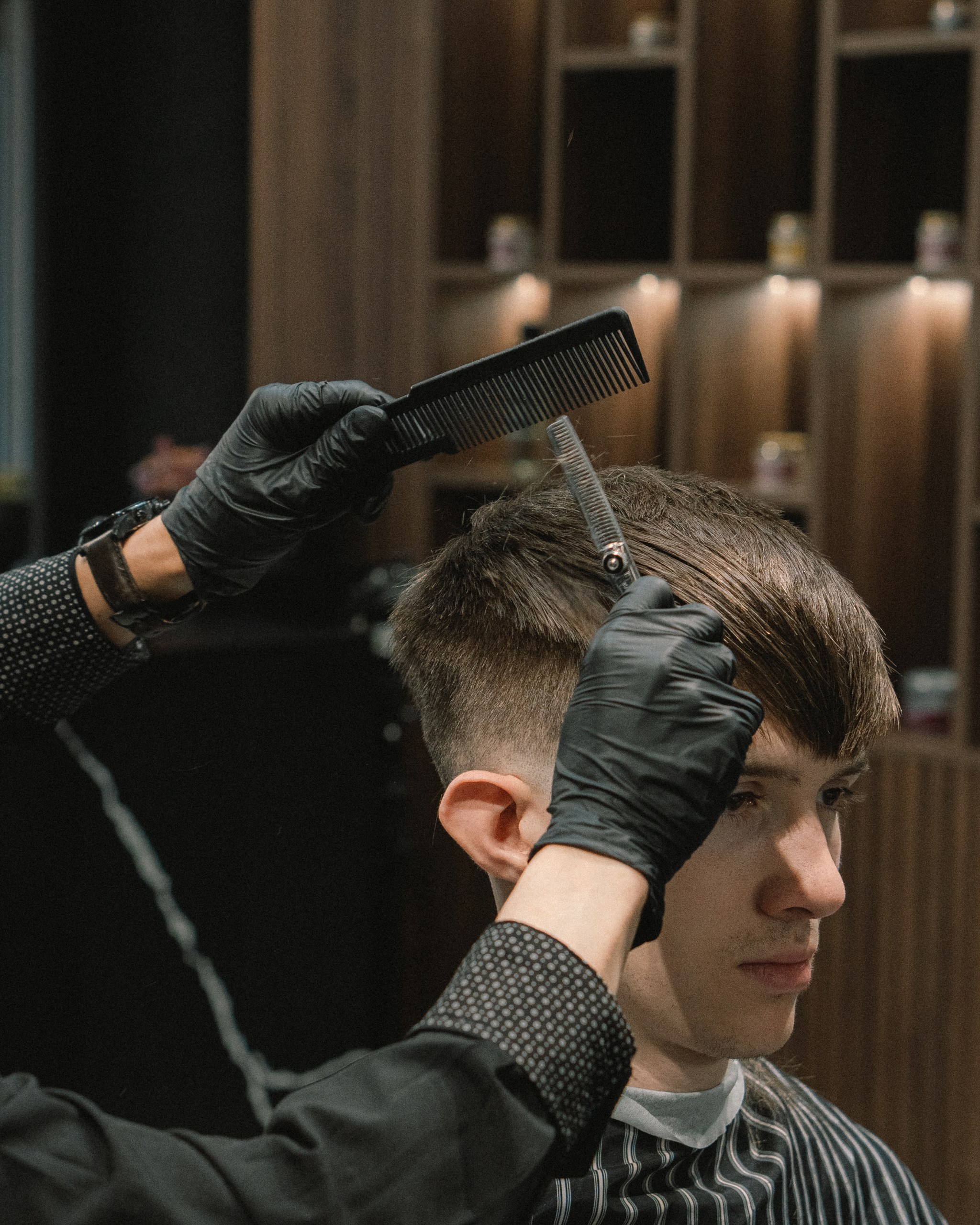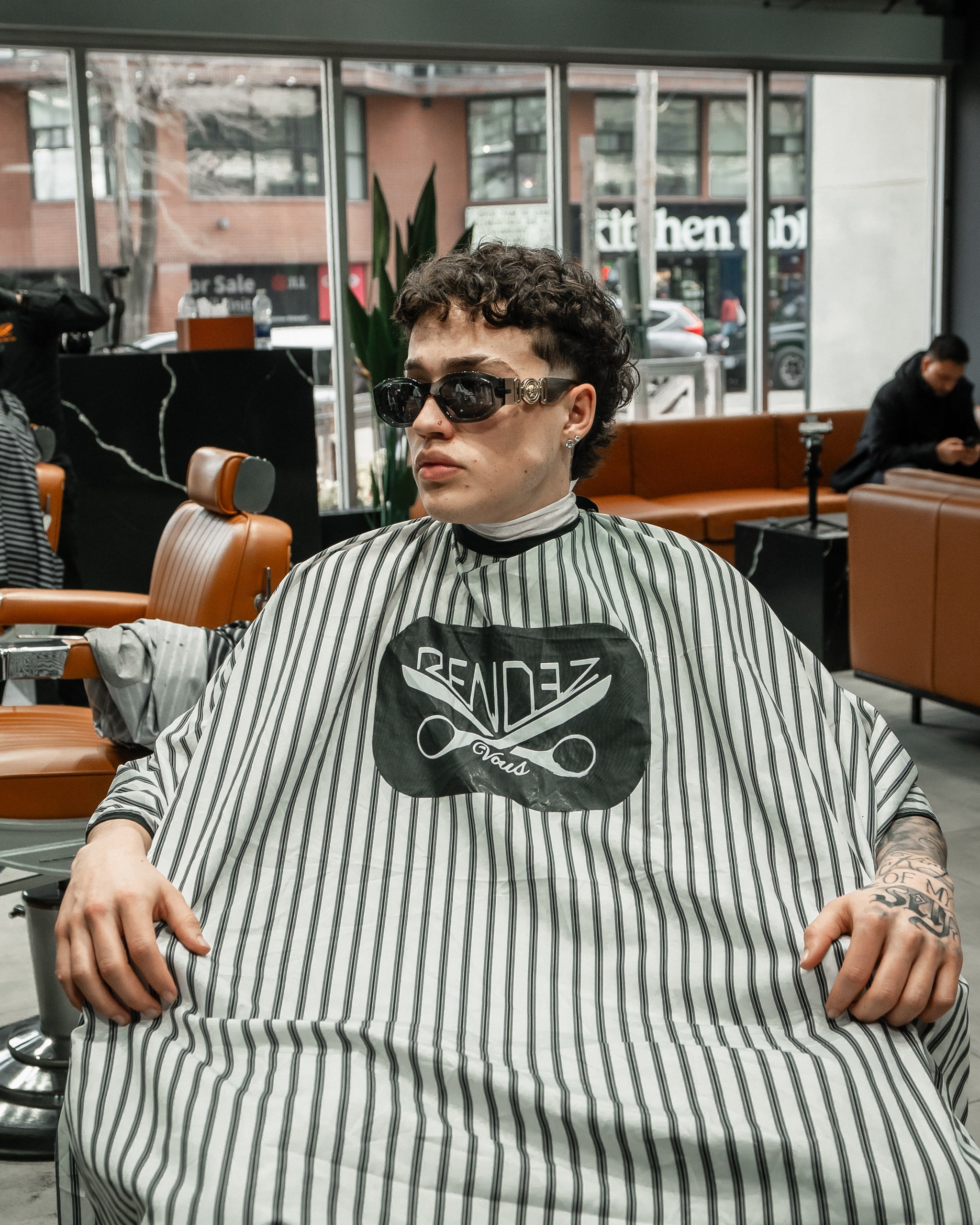Ever notice how your sideburns need trimming every two weeks, but the hair on top seems to grow at a snail's pace? Or wonder why some guys can rock a perfect buzz cut while others look like they stuck their finger in an electrical socket? The answer isn't luck – it's biology.
At Rendezvous Barbers, we field these questions daily. Guys come in frustrated because their hair won't cooperate, grows unevenly, or behaves completely differently than their buddy's hair. Here's the thing: your hair follicles aren't identical little soldiers marching in formation. They're more like a diverse workforce, each with different jobs, different schedules, and different capabilities.
Understanding how your follicles actually work – and why location matters so much – changes everything about how you approach your hair.
Think of Follicles as Tiny Hair Factories
Picture this: buried under your scalp are millions of microscopic factories. Each one has a single job – produce hair. But like any manufacturing operation, some factories are more efficient than others, some have better supply chains, and some are working with outdated equipment.
The factory floor: At the bottom of each follicle sits something called the dermal papilla. This is basically the factory manager. It decides how fast to produce hair, how thick to make it, and when to shut down operations entirely. Some managers are go-getters who keep production humming along. Others are more laid-back and take frequent breaks.
The assembly line: Hair gets built from the bottom up, starting as a cluster of cells that multiply and push upward through the follicle tunnel. Think of it like a Play-Doh machine – the hair gets formed and extruded through the opening. The speed of this process varies dramatically depending on which factory (follicle) we're talking about.
Quality control: Each follicle has its own standards. Some produce thick, strong hair that could probably tow a small car. Others specialize in fine, delicate strands that break if you look at them wrong. This isn't a design flaw – it's intentional variation.
The key insight? You've got different types of factories running different operations all over your head. No wonder your hair doesn't behave uniformly.
Your Scalp is Like Different Neighborhoods
If follicles are factories, then different areas of your scalp are like different industrial districts. Each neighborhood has its own infrastructure, resources, and operating conditions.
The crown district (top of your head): This is like the downtown core – high-density, high-stakes territory. You've got more follicles per square inch here than anywhere else, sometimes over 300 per square centimeter. When this area is firing on all cylinders, you get that thick, full look that makes other guys jealous. But it's also the most vulnerable neighborhood, prone to "gentrification" (thinning) as you age.
The sides and back suburbs: These are the stable, reliable neighborhoods. The follicles here are like that friend who's had the same job for 20 years and never misses a mortgage payment. They're not flashy, but they're consistent. Hair growth here stays steady, and these follicles are naturally resistant to most of the problems that plague other areas.
The hairline frontier: This is like living on the edge of town – exposed to the elements and constantly under siege. These follicles deal with more environmental stress (sun, wind, pollution) than their protected neighbors. They're the first to show wear and tear, which is why hairline recession is so common.
Facial hair territory: This is a completely different jurisdiction with different laws. Beard and mustache follicles operate under different regulations entirely. They're actually energized by the same hormones that can shut down scalp hair production. It's like they're running on a completely different power grid.
Understanding your personal neighborhood map helps explain why your hair behaves the way it does.

The Great Growth Rate Mystery Solved
Here's where it gets interesting. Hair doesn't grow at the same speed everywhere, and the differences are bigger than most guys realize.
Scalp hair speed limits: Your average scalp hair grows about half an inch per month. But that's just an average. Hair at the back of your head often grows faster than hair on top. Why? Better blood supply and less interference from hormones that can slow things down.
The sideburn speedway: Sideburns are technically facial hair, not scalp hair, which explains why they seem to grow overnight. They're operating under facial hair rules, which means faster growth and different sensitivity to hormones. This is why your sideburns always seem to need trimming before the rest of your haircut grows out.
Facial hair acceleration: Beard hair can grow as fast as scalp hair, but it seems faster because you're starting from zero every time you shave. Plus, facial hair is often thicker and more noticeable, so the same amount of growth looks like more progress.
The mustache phenomenon: Mustache hair often outpaces beard hair. The area above your lip has particularly good blood circulation and nerve supply, creating optimal growing conditions. This is why some guys can grow a respectable mustache but struggle with a full beard.
These speed differences explain why maintaining any specific style requires a customized trimming schedule. Your barber isn't just cutting hair – they're managing multiple growth rates simultaneously.
Blood Supply: The Highway System
Think of your scalp's blood vessels like a highway system delivering nutrients and oxygen to follicles. Some areas have multiple six-lane highways with perfect traffic flow. Others are stuck with winding back roads and frequent traffic jams.
The express lanes: The sides and back of your head have excellent circulation. Multiple arteries feed these areas, creating redundant supply routes. When follicles get everything they need consistently, they perform at their best. This superior infrastructure is one reason why these areas tend to maintain healthy hair longer.
Rush hour traffic: The crown area has more limited blood supply, especially as men age. The scalp gradually gets tighter over time, compressing blood vessels and creating traffic bottlenecks. When follicles can't get adequate nutrition and oxygen, their performance suffers. They start producing thinner, weaker hair and eventually may shut down entirely.
The massage bypass: This is why scalp massage actually helps. It's like opening temporary bypass routes around traffic jams. While you can't permanently fix circulation problems with massage, you can temporarily improve blood flow to struggling areas. It's not magic, but it's real.
Understanding your scalp's circulation patterns helps explain why some areas thrive while others struggle.
Follicle Density: The Population Factor
Not every square inch of your scalp has the same population of follicles. These density differences create optical illusions that affect how thick your hair appears.
High-density housing: The crown typically has the highest follicle concentration. When these follicles are healthy and producing normal hair, this creates impressive thickness and coverage. But high density is a double-edged sword – when follicles start to miniaturize or shut down, the thinning becomes very obvious very quickly.
Medium-density developments: The sides and back have fewer follicles per square inch, but each follicle tends to be larger and more robust. This combination can actually create the appearance of thicker hair than high-density areas with weaker individual follicles.
The buzz cut test: Whether you can pull off a buzz cut depends largely on your natural density patterns. Guys with even density across their scalp look great short. Those with significant density variations need strategic length to create the illusion of uniform thickness.
Your natural density pattern is genetic and unchangeable, but understanding it helps you choose styles that work with what you've got.
Working with Your Natural Architecture
Once you understand your follicle geography, you can make smarter decisions about styling and maintenance.
Strategic cutting: A skilled barber considers growth rate differences when planning your cut. They might leave slightly more length in slower-growing areas to compensate for the fact that faster-growing areas will need trimming sooner. This helps maintain the style's proportions longer.
Realistic expectations: If an area naturally has lower density or produces finer hair, no amount of product or styling will make it behave like a high-density zone with thick follicles. Working with your natural patterns always produces better results than fighting against them.
Maintenance scheduling: Understanding which areas grow faster helps you plan touch-ups. Maybe you need sideburn trims every two weeks but only need the top trimmed monthly. Custom schedules save time and money while keeping you looking sharp.
Product strategy: Different areas may need different approaches. Fine hair areas might benefit from volumizing products, while thick areas might need smoothing formulas. One-size-fits-all rarely works when dealing with varied follicle types.
Age-Related Changes
Follicles don't remain static throughout your life. They evolve, and understanding these changes helps set appropriate expectations.
Peak performance years: In your teens and twenties, follicles operate at maximum efficiency. Growth rates are fastest, hair is thickest, and recovery from damage happens quickly. This is why haircuts seem to grow out faster when you're young – they actually do.
The gradual slowdown: Starting in your thirties, follicles begin a gradual decline. Growth rates slow slightly, hair diameter may decrease, and some areas become more sensitive to hormones and environmental stress. These changes happen slowly over years, not suddenly.
The adaptation period: Learning to work with changing follicle behavior is part of aging gracefully. Styles that worked in your twenties might need adjustment in your forties, not because you're doing anything wrong, but because your follicles are operating under different conditions.
When Normal Becomes Concerning
Most follicle variations are completely normal, but certain changes warrant professional attention.
Sudden dramatic changes: If growth patterns change rapidly or one area starts behaving very differently from usual, it could indicate circulation problems, nutritional deficiencies, or other health issues affecting follicle function.
Asymmetrical behavior: If one side of your head starts growing significantly faster or slower than the other, or if texture changes dramatically on one side, it's worth investigating potential causes.
The Bottom Line
Your hair follicles are not identical units producing uniform results. They're diverse, specialized structures operating under different conditions across your scalp. Understanding this biological reality changes how you approach hair care entirely.
Instead of fighting against your natural patterns, you can work with them. Instead of expecting uniform behavior, you can appreciate the unique characteristics of different areas. Instead of pursuing impossible standards, you can optimize what you actually have.
The guys who always seem to have great hair aren't necessarily blessed with perfect genetics – they're working smart, not hard. They understand their follicle geography and make decisions accordingly.
Conclusion
Ready to work with your hair instead of fighting it? Book your appointment today and see how knowing your hair's natural patterns can make everything easier.













